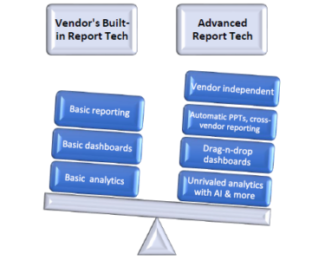Have you ever noticed the less your HR application provides, the more $$$ the vendor makes?
HR application vendors primarily make money off two things: subscriptions and services. What their applications lack in functionality is often turned into revenue when their services team is forced to develop workarounds to address those limitations and satisfy your business requirements. What’s worse is when they require you, the client, to develop your own workarounds. Again.
The most common examples are limitations in reporting technology. Full transparency: we do a lot of report development using the built-in technology in HR applications, so we know the pros-and-cons of these type of systems. Just how does report tech in HR applications let clients down?
1. GETTING LOCKED INTO PROPRIETARY TECH! Clients often feel they are locked into vendor’s proprietary or uncommon report technology and therefore locked into the high cost of development and user training as they require specialized resources.
2. “IT COSTS HOW MUCH TO REDEVELOP REPORTS?” Clients are often forced to re-develop existing reports when vendors no longer support their legacy report technology or the client switches vendors.
3. DATA HERE AND DATA THERE. Some reports and analytics are impossible in a single HR system, since data is spread among several systems. This results in workarounds to stitch together data for CEO presentations, cross-application analysis, etc. which rely on data from multiple HR applications.
4. ADVANCED THEY’RE NOT. Vendor report tech often covers the basics, but they don’t offer AI, Machine Learning, creative visualizations, easy changes, and awesome mobile experience that the latest analytics tools offer. App vendors rarely make substantial changes and invest in future-proof, advanced analytic technologies when the status quo results in services revenue for the workarounds required to meet your needs!
The solution? Invest in report tech not tied to a specific vendor. Vendor’s change, but your analytics and reports should not. Keep your investment in reports and analytics regardless of the vendor you use!
“We encourage clients to follow a ‘vendor neutral’ course for reporting and analytics. This allows for the use of standard platforms with low training costs and advanced functionality without the cost of redevelopment when applications are upgraded or you switch vendors.”
– Dan Schreck
